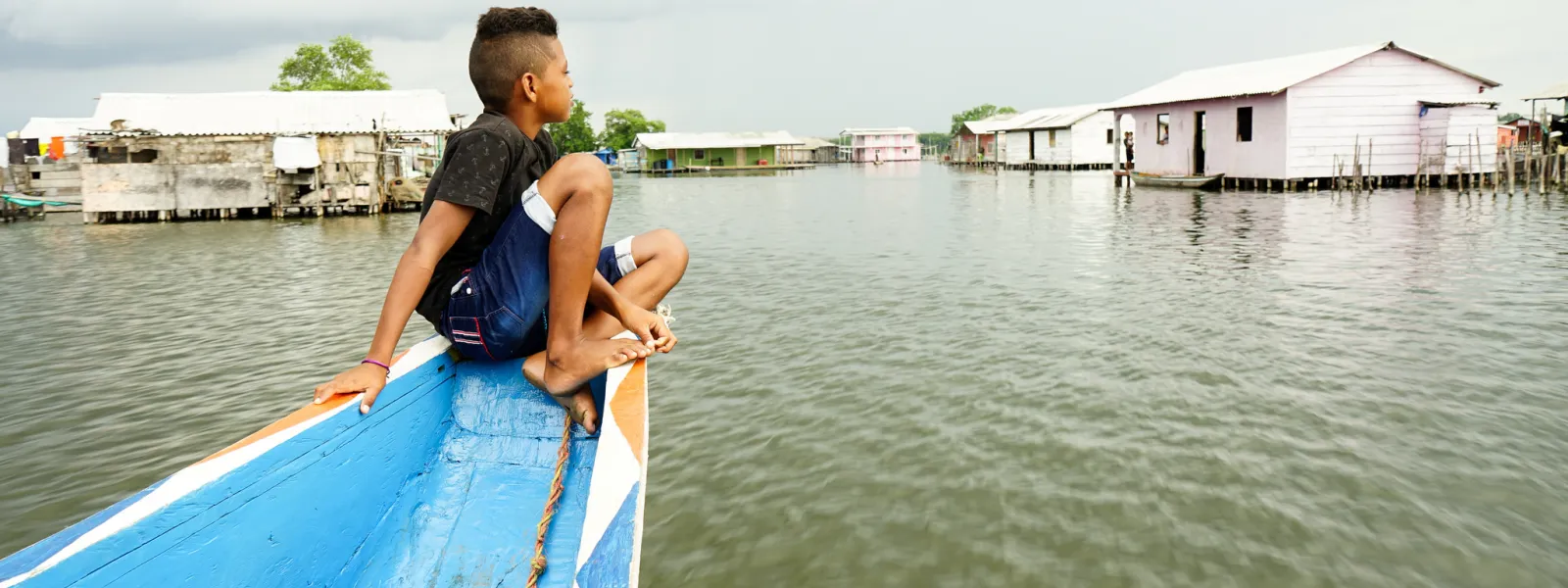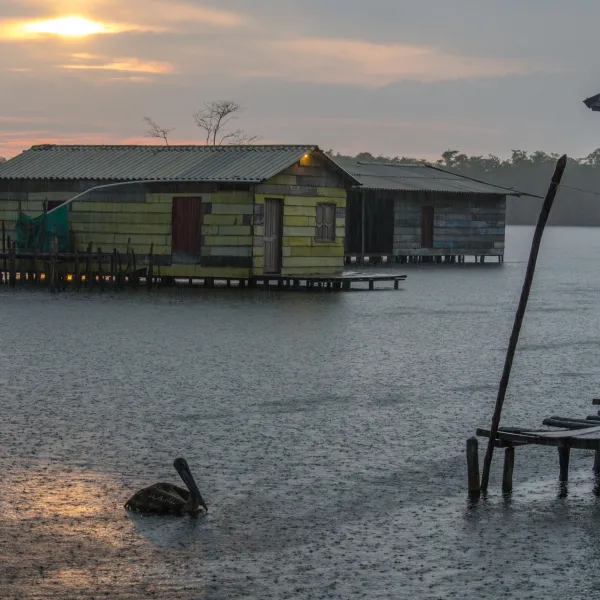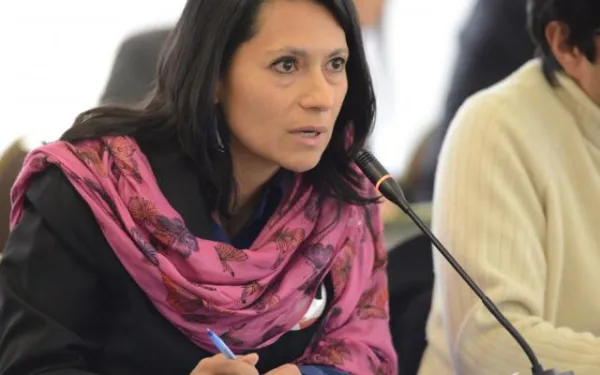
Project
Photo: Anna Laurie Miller / AIDAConserving the Ciénaga Grande de Santa Marta
Ciénaga Grande de Santa Marta, the largest and most productive coastal wetland in Colombia, covers 45,000 hectares. At the confluence of the Magdalena River and the Caribbean Sea, the site boasts an immense variety of flora and fauna, including mammals, birds and fish. Its southern tip is a beautiful sanctuary of mangroves, swamp and amphibious forest.
On the calm waters of the marsh stand the Ciénaga’s famous stilt villages, supported by pillars or simple wooden stakes and inhabited by local fishermen since 1800. In a place accessible only by water, many of the things we take for granted—being served a glass of water, quick access to a doctor—are considered luxuries. Residents depend on the natural world around them. Sadly, in recent years mass fish die-offs caused by the marsh’s degradation have threatened the livelihoods of 2,500 people who call the Ciénaga Grande home.
Illegal activities are destroying this vital ecosystem: intentionally set forest fires, deforestation of large tracks of land for agriculture and livestock, logging and burning of mangroves, and 27 kilometers of illegally built dikes.
This destruction not only devastates the local fishery; it also has global impact. Ciénaga Grande’s mangroves absorb large quantities of carbon dioxide from the atmosphere, aiding in the global fight against climate change.
The importance of the Ciénaga Grande has been recognized both nationally – the Sanctuary of Flora and Fauna Ciénaga Grande de Santa Marta is a national park – and internationally: UNESCO’s Man and the Biosphere program declared the lagoon a biosphere reserve; and the Ciénaga Grande is listed as a Wetland of International Importance under the Ramsar Convention, an intergovernmental treaty for the protection of wetlands.
AIDA and our partners are advocating for the Colombian government to fulfill its national and international obligations to protect the Ciénaga Grande. After all, millions of animals, the local community, and our global climate depend on it.
Partners:

Related projects
COP20: It’s All On Our Shoulders Now
ECO/Climate Action Network We are very happy to be in Lima, and ECO is ready to get right to it. COP20 needs to deliver on enough confidence building measures to ensure climate action and a successful outcome from next year’s COP in Paris. The wheels have already started turning: The Peruvian COP presidency has shown commitment and substantial effort to guide the negotiations onto the right track. The US-China climate announcement, on the heels of similar action by the EU, has injected positive impetus into the political aspect of the negotiations – and is pressuring significant laggards and defaulters, who can no longer claim inaction by the G2 to wiggle out of doing their part. The IPCC is shining clear light on the latest science, pointing urgently to deeper climate action as well as the fast-rising costs of delay. The GCF is seeing some light at the dim end of the climate finance tunnel with pledges at $9.7 billion for initial capitalization – though that’s welcome, it must not distract from the pressing need to scale up finance within the new agreement. Are these announcements and developments enough to create the right confidence building measures across countries, cement the foundation for greater political will and achieve success in Paris? ECO surely hopes so – but let’s be clear, this opening round of mitigation announcements must not be a resting place but rather a starting point that Parties will broaden and expand. The agreement in Paris is going to rest on three key decisions here in Lima: the elements of the 2015 agreement, the iNDC upfront information requirements, and ways to ramp up pre-2020 ambition. These outcomes are going to define the contours of the new global agreement. So let’s look a bit closer. The elements text must include a long-term goal of phasing out all fossil fuel emissions and phasing in 100% renewable energy as early as possible, but not later than 2050. We also expect to see goals for public finance along with a robust and honest MRV regime for them; a global adaptation goal that enables adaptation to be mainstreamed; and a strengthened two-year work plan to immediately operationalize the Warsaw loss and damage mechanism and to ensure that loss and damage has its appropriate place within the 2015 agreement. Not so easy, right? Well, don’t worry, as always, ECO is here to help. And with that in mind, we also look forward to seeing the inclusion of an enhanced role for civil society in the text. To be clear, we have high hopes for the iNDC text. The iNDCs should include mitigation with regular 5-year cycles of contributions, starting with countries putting forward their contributions for the 2020-2025 cycle, provision and mobilization of finance as part of countries’ fair share of the global effort, and voluntary adaptation contributions. Not only that, all current and future contributions must undergo a sound, robust equity and adequacy assessment phase to help drive up ambition and ensure that low ambition is not locked in by any country. The first round of iNDCs will set the tone for the future. We’ve really got to get it right on this one – it is no exaggeration to say the future of human civilization is weighing on all our shoulders. And every step counts. The effectiveness of the post-2020 agreement to be reached in Paris next year depends on the progress we make between now and 2020. On pre-2020 finance it’s simple: developed countries have to present a credible roadmap on how they are going to meet their $100 billion promise, deliver additional pledges to the GCF (this means you, Australia, Austria, Belgium, Iceland and Ireland) and also not let the Adaptation Fund dry up. We need finance and a full set of means of implementation and support to unlock untapped potential in countries and sectors that can deliver greater ambition for reducing emissions, as well as assisting vulnerable communities that are already facing impacts from climate change. On mitigation, what has the latest IPCC report taught us? All countries need to increase their pre-2020 mitigation commitments, and deliver on them through real mitigation actions. As session after session has shown, climate impacts do not stick to UNFCCC timelines; the atmosphere sees what we do, not what we think. The pressure is on but ECO is confident we can respond. We’ve got a lot of work to do, and there is no time to lose. Archivado en: English
Read moreWelcome!
Each year, representatives of a variety of nations unite with one purpose: to spur international action to combat climate change. However, in the 20 years that these meetings have been taking place, the international community has yet to reach a definitive agreement. The topics covered are many, but the most important demands are that the nations commit to reducing their greenhouse gas emissions, and that they assist in the creation of a joint economic fund that will help to mitigate the impacts of climate change in developing countries. With the purpose of informing and representing civil society, AIDA‘s team will be present in Lima to take part in the activities of the COP20 and the People’s Summit. We will be closely following the themes of climate finance, the Green Climate Fund, human rights and climate change, dams and fracking. Thank you for following along with us! Archivado en: English, Noticias
Read more
Revealing the Impact of Development on Human Rights and the Environment
"There we were – men and women, boys and girls, elders and community leaders – who dared to reject the burning of our homes on the river’s edge, the theft and loss of our things, the mistreatment, the insults, the humiliation from the police, the Army and public companies of Medellín, who forcibly emptied the river banks to make way for development." With these words, Isabel Cristina Zuleta gave testimony before the Inter-American Commission on Human Rights last month, describing the situation that she and thousands of Colombians have been suffering through. Zuleta, the leader of Movimiento Rios Vivos (Living Rivers Movement), is a victim of forced displacement – caused by the Hidroituango hydroelectric project in Colombia – and she is not alone. AIDA’s Co-Executive Director Astrid Puentes participated in the hearing alongside Rios Vivos, Tierra Digna, Asoquimbo, Comisión Intereclesial de Justicia y Paz, Corporación Jurídica Libertad, and other partner organizations from Colombia. She argued before the Commission that, in Colombia, forced displacement caused by development projects, such as mines and dams, is not recognized as a human rights violation by the State, which leaves affected communities unprotected. During the hearing Puentes introduced the three primary causes of forced displacement from these projects: the close relationship between armed conflict and major development projects; the flexibility and violation of rules in their authorization and implementation; and the direct impacts of their operation. She asked the Commission to urge the Colombian State to guarantee rights to the victims, repair damages, and take appropriate measures to prevent displacement in the future. Puentes described human rights violations caused by specific projects, such as El Quimbo dam, which displaced hundreds of families in Huila Department, and coal mines in La Jagua de Ibirico, in Cesar Department, where air pollution displaced entire communities. The inadequate implementation of development projects in Colombia, and in the region, also violates Economic, Social and Cultural Rights (ESCR), especially the right to a healthy environment. In this regard, AIDA and organizations from the region participated in a hearing called by the Commission to analyze the situation of ESCR on the continent. In it, Maria José Veramendi Villa, a senior AIDA attorney, noted that States mainly fail to protect the right to a healthy environment by implementing mining, energy, and infrastructure projects. The problem has only worsened in recent years. "The Commission has found different manifestations of this problem over the course of at least 40 hearings, conducted over the last decade, which have illustrated the serious territorial, cultural, and environmental conflicts created by the violations of ESCR," said Veramendi during the hearing. We need an Inter-American Human Rights Commission that is firm and decided in its position towards development projects that violate human rights and that brings justice to those who cannot find it in their countries.
Read more